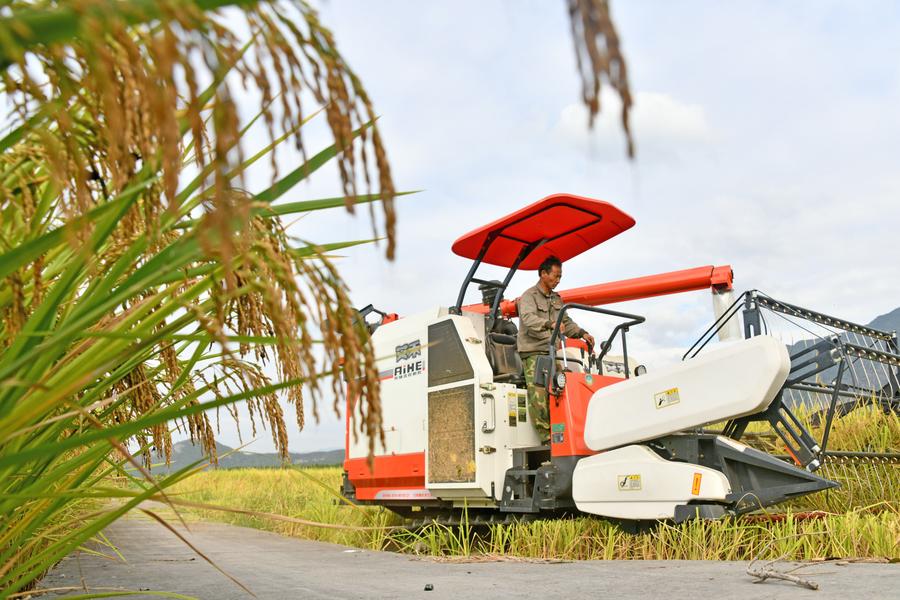Study reveals 100,000-year evolution from wild to domesticated rice

A farmer operates an agricultural machinery to harvest rice at Baita Town of Xianju County in Taizhou, east China's Zhejiang Province, Oct. 5, 2023. (Photo by Wang Huabin/Xinhua)
BEIJING, May 24 (Xinhua) -- A team of Chinese scientists has unveiled the continuous evolutionary history of rice, tracing its journey from wild to domesticated over an astounding period of 100,000 years.
The findings published on Friday in the journal Science not only shed new light on the progression of human society and the origins of agricultural civilization, but also present compelling evidence that China is the birthplace of rice.
The cultivation and domestication of rice, a dietary staple for billions worldwide, have exerted a significant influence on the evolution of Chinese civilization.
Scholars from various academic fields have long been captivated by the study of how humans first began cultivating wild rice and the evolutionary journey from wild to cultivated strains.
Archaeological findings of rice at sites like Hemudu and Shangshan in the Yangtze River's middle and lower valleys since the 1970s have shed light on the region's pivotal role as a cradle for rice cultivation.
However, identifying well-preserved markers that differentiate wild from cultivated rice in the region, dating back to the last glacial maximum, and elucidating the mechanisms and processes behind early human exploitation, cultivation and domestication of wild rice, continued to be central challenges in archaeological research.
The research team that led by Professor Lyu Houyuan from the Institute of Geology and Geophysics under the Chinese Academy of Sciences conducted a systematic study on phytoliths in modern wild and domesticated rice plants and soils.
They found that the increase in the number of fish-scale facets on the bulliform phytoliths correlates with the trait of domestication. Based on these findings, they developed a standard for distinguishing wild rice from its domesticated counterparts.
Employing this benchmark, the research group delved into the archaeological layers and natural profiles of the Shangshan site and the Hehuashan site in east China's Zhejiang Province.
The analysis revealed a continuous trajectory of rice from wild to domesticated within the layer of Shangshan cultural site and its relationship with human activities and climate change.
Wild rice was already prevalent in the lower Yangtze River region approximately 100,000 years ago, laying the groundwork for the subsequent utilization and domestication of rice, according to the study.
Approximately 24,000 years ago, coinciding with the onset of the Last Glacial Maximum, human ancestors began gathering and utilizing wild rice. This adaptation allowed them to seek new sources of food amidst the challenges posed by the cooling climate.
About 13,000 years ago, they embarked on the practice of rice cultivation. By approximately 11,000 years ago, there was a rapid rise in the prevalence of phytoliths characteristic of domesticated rice, which surpassed the threshold indicative of domestication.
"Our research uncovered that the inception of rice agriculture in East Asia and wheat agriculture in the Southwest Asia transpired concurrently," said Prof. Zhang Jianping from the Institute of Geology and Geophysics, one of the corresponding authors of the study.
"It represents a significant milestone in the history of human development and has greatly deepened our understanding of the global origins of agriculture," said Zhang.
Also, the 100,000-year-long record of wild rice distribution, culminating in its domestication at the Shangshan cultural site, reveals the intricate interplay among rice, climate, human practices and cultural evolution, according to Zhang.
This innovative discovery significantly impacts our understanding of human-rice co-evolution, human societal development, the origins of agricultural civilization and the importance of Shangshan culture, commented the peer reviewer of the study.
Photos
Related Stories
- New findings illuminate details about SW China ancient capital
- Cattle bone powder first discovered in pottery bonding from China's ancient horse statue
- Archaeological excavation at Wuwangdun tomb in Anhui yields major findings
- Tomb excavation in China's Anhui yields major discoveries
- Digital technologies restore looks of 2,200-year-old woman
Copyright © 2024 People's Daily Online. All Rights Reserved.









